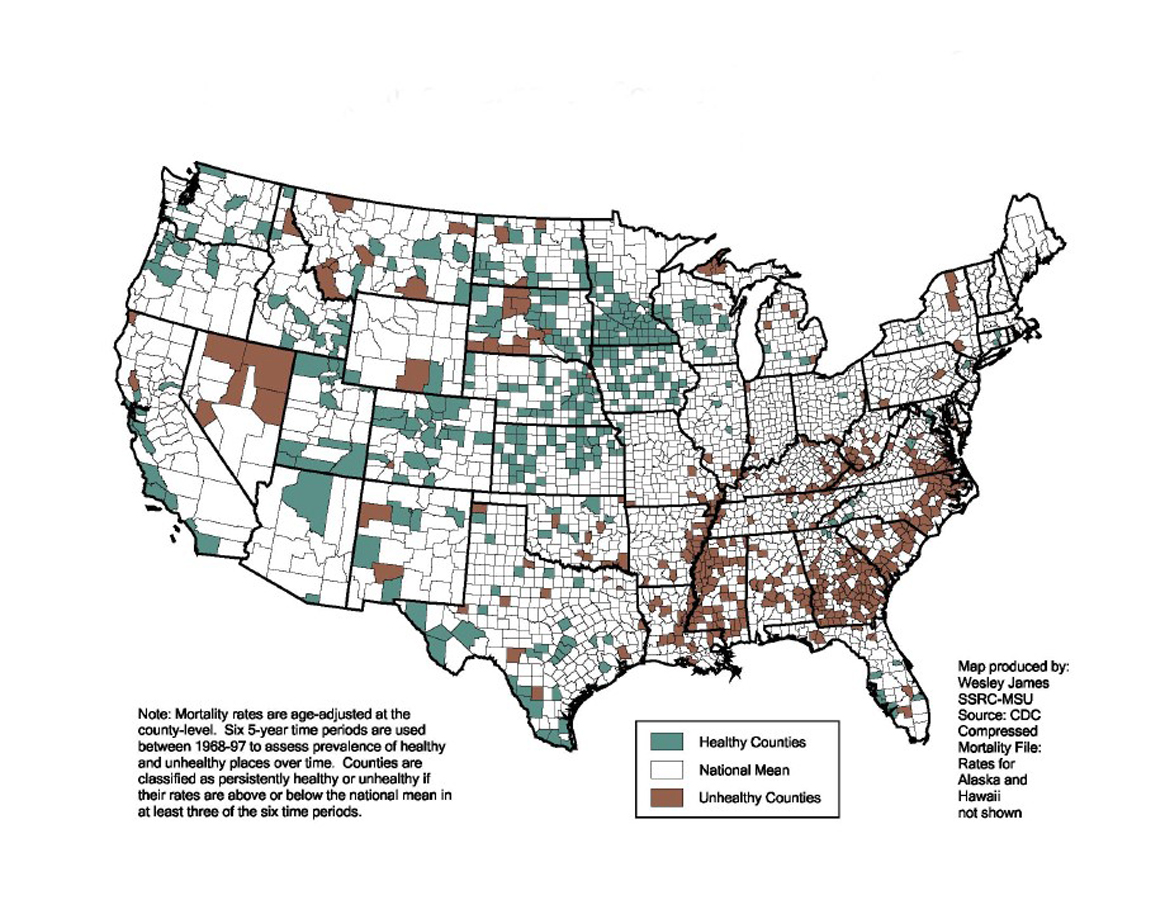Contact: Maridith Geuder

Healthy and unhealthy places around the nation, as mapped by the Social Science Research Center
Last year, Mississippi State medical sociologist Lynne Cossman and medical geographer Ronald Cossman released a detailed report spotlighting clusters of "healthy" and "unhealthy" places throughout the United States.
Now, the research team at the university's Social Science Research Center is seeking to discover whether those locales--including many in Mississippi--correlate with the medical prescription of drugs for chronic diseases. If successful, the two will have developed a powerful new tool for identifying national pockets of illness.
The Cossmans will use prescription drug data drawn from 75 percent of all U.S. retail pharmacies. Funded by the U.S. Office of Rural Health Policy, the yearlong effort seeks to determine whether prescription drug data can generate reliable and valid information about disease and death rates at the county level.
"Currently, there is no existing county-level data," said Lynne Cossman. "We know there are geographic concentrations of mortality rates that persist over time, but we don't know if, or how, these relate to specific diseases."
The team's approach will test whether prescription drug data can serve as an indirect measure--or proxy--for chronic illnesses, Ronald Cossman explained. Conducted under the auspices of the SSRC's Mississippi Health Policy Research Center, the work is believed to be the first to take an explicitly geographic approach.
"We'll look at prescription drug data for the top mortality-causing diseases, as well as selected non-fatal illnesses that have disability implications," Ron Cossman said. Included will be prescription drugs related to heart disease; cerebrovascular diseases; bronchitis, asthma, and emphysema; diabetes; sinusitis and allergies; arthritis; attention deficit-hyperactivity disorder; and pain management.
In the United States, chronic diseases account for 60 cents of every dollar spent on health care. With this in mind, Lynne Cossman said understanding the geographic distribution "is one step in ensuring that resources are appropriately matched to needs."
The Cossmans and other research colleagues on the team will correlate prescription drug data with a variety of other sources, including U.S. Census data and the annual Behavioral Risk Factor Surveillance Survey of the Centers for Disease Control. In addition to identifying locations with exceptional rates, they'll seek to find if any chronic-illness commonalities exist.
With the data, they then can visually display the geographic variability of disease prevalence, comparing it with their earlier maps based on death rates. By extending their study, they also can test whether prescription drug rates are a valid predictor of death rates.
"If there is a correlation, the health care policy implications are dramatic," Lynne Cossman said. "In particular, we want to test whether locations with extraordinary prescription prevalence may share similarities in health infrastructure, socioeconomics and demographics that can explain the disparities in death rates."
By better understanding connections between location and disease, the MSU researchers said they hope to make a positive impact on the early prevention of disease.
"If chronic disease rates can be estimated, mapped and analyzed at the county level, we may identify opportunities for targeted health care interventions," Lynne Cossman said.
Added Ron Cossman: "This research is an important step in the process of understanding the fundamental role of place versus people in health outcomes prior to death."
Also participating in the study are SSRC director Arthur G. Cosby, sociologist Troy Blanchard and graduate student Wesley James of Conway, Ark., all of MSU. Others on the team include Richard Thomas of the University of Tennessee Health Science Center and Louis Pol of the University of Nebraska, Omaha.
For more information about the study, telephone Lynne Cossman at (662) 325-7880 or Ron Cossman at 325-4801.